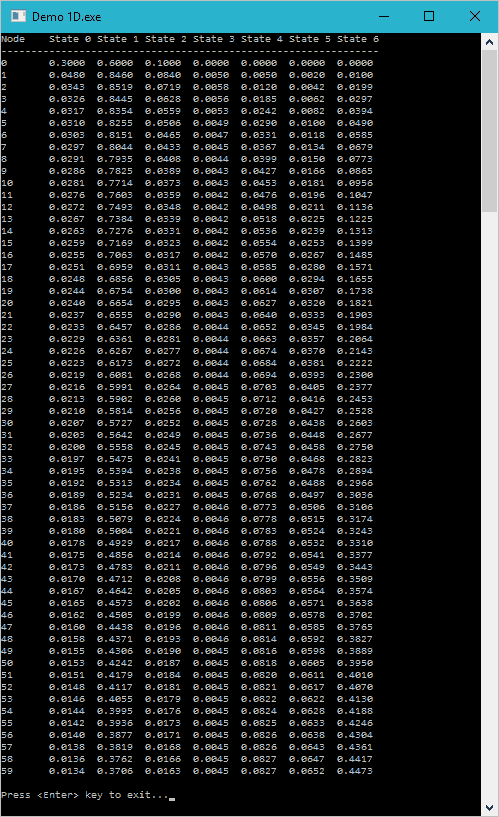 |
Direct Graphical Models
v.1.7.0
|
 |
Direct Graphical Models
v.1.7.0
|
In this demo we consider more complex problem involving the chain of nodes. Such a problem is common in Markov chains and hidden Markov models These models may incorporate large graphs, what prevents from using brute-force exact decoding and inference algorithms. Nevertheless, we can take an advantage of the conditional independence properties induced by the chain structure and use polynomial-time exact message-passing inference algorithm. This example copies the idea from the Computer Science Graduate Careers
In order to run this demo, please execute "Demo 1D.exe" chain command
We build a chain, consisting of 60 nodes, which represents 60 years. Every node has 7 states and the first, initial node will have the potential: \((0.3, 0.6, 0.1, 0, 0, 0, 0)^\top\), whereas all other nodes are initiated with uniform distribution: \((\frac{1}{7}, \frac{1}{7}, \frac{1}{7}, \frac{1}{7}, \frac{1}{7}, \frac{1}{7}, \frac{1}{7})^\top\). We connect all nodes into a chain with undirected arcs:
The edge potential matrix is represented here as a transition matrix:
| from\to | st.0 | st.1 | st.2 | st.3 | st.4 | st.5 | st.6 |
|---|---|---|---|---|---|---|---|
| st.0 | 0.08 | 0.90 | 0.01 | 0 | 0 | 0 | 0.01 |
| st.1 | 0.03 | 0.95 | 0.01 | 0 | 0 | 0 | 0.01 |
| st.2 | 0.06 | 0.06 | 0.75 | 0.05 | 0.05 | 0.02 | 0.01 |
| st.3 | 0 | 0 | 0 | 0.30 | 0.60 | 0.09 | 0.01 |
| st.4 | 0 | 0 | 0 | 0.02 | 0.95 | 0.02 | 0.01 |
| st.5 | 0 | 0 | 0 | 0.01 | 0.01 | 0.97 | 0.01 |
| st.6 | 0 | 0 | 0 | 0 | 0 | 0 | 1 |
e.g. a probability of switching from state 3 at year i to state 5 at year i + 1 is 0.09. The node and edge potentials are returned with functions getNodePot() and getEdgePot() respectively.
The number of all possible configurations for our chain is equal to \(7^{60}\approx 5.08\times 10^{50}\), and it is not feasible to calculate joint probabilities for all of these configurations. Nevertheless, DGM has exact inference method for chains DirectGraphicalModels::CInferChain, which is based on a message-passing algorithm with the total cost of evaluating the marginals of \(O(nNodes\cdot nStates^2)\):
Finally, we depict the results of inference. Please note, that the marginal probability for the first node is equal to the initial probability:
